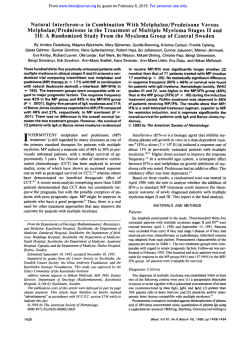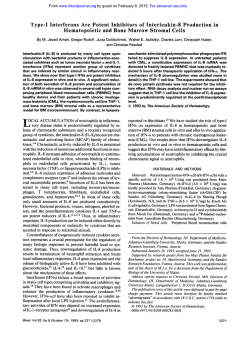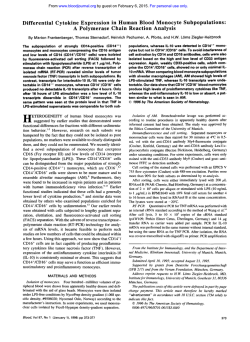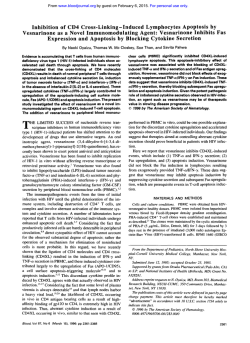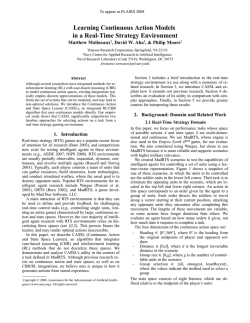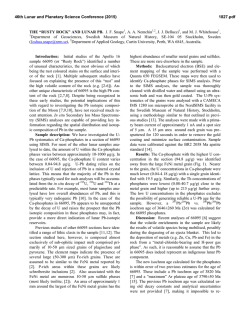
Interferon-a Stimulates Production of Interleukin-10 in
From www.bloodjournal.org by guest on February 6, 2015. For personal use only.
Interferon-a Stimulates Production of Interleukin-10 in Activated CD4+ T
Cells and Monocytes
By M. Javad Aman, Theresa Tretter, Ilona Eisenbeis, Gesine Bug, Thomas Decker, Walter E. Aulitzky, Herbert Tilg,
Christoph Huber, and Christian Peschel
In the present study, we investigatedthe effect of interferona (IFN-a) on the expression of interleukin-10 (IL-10) mRNA
and protein synthesis in human monocytesand CD4+T cells.
In mononuclear cells, IFN-a induced expression of IL-10
mRNA and further enhanced lipopolysaccharide (LPS)-stimulated IL-10 expression. In purified monocytes, a strong expression of IL-10 mRNA induced by LPS was not further
enhanced by IFN-a. In highly purified CD4+ T cells, IFN-(U
upregulated IL-10 mRNA upon activation with phytohemagglutinin and phorbol myristate acetate. In purified monocytes, an effect of IFN-a on IL-10 protein synthesis was dependent on costimulation with LPS. Maximal stimulation of
IL-10 protein by IFN-a was seen after prolonged incubation
periods of 48 t o 96 hours, whereas IFN-y reduced IL-10 production in the early incubation period. Similar effects of IFNa were observed in CD4+ T cells activated with CD3 and
CD28 monoclonal antibodies. Addition of IFN-a caused an
increase of IL-10 in culture supernatants of activated Thelper cells of more than 100% after 96 hours of incubation.
In contrast, other cytokines, including IFN-y and IL-4, had
no influence on IL-10 secretion stimulated by CD3 and CD28
in CD4‘ T cells. In serum samples of IFN-a-treated individuals, we failed t o detect an influence of cytokine treatment on
IL-10 serum levels, confirming the requirement of additional
activating signals for IFN-a-mediated effects on IL-10 synthesis. In conclusion, IFN-a enhances the late induction of
IL-10. which physiologically occurs upon stimulation of
monocytes and T cells. Biologically, this effect might enhance the negative-feedback mechanism ascribed t o IL-10.
which limits inflammatory reactions.
0 1996b y The American Society of Hematology.
I
tute of Immunology, Vienna, Austria). CD28 was obtained from
Jansen (Briiggen Bracht Germany), CD8, CD14, CD19, and CD56
MoAbs from Coulter (Krefeld, Germany), and CD16 from Becton
Dickinson (San Jose, CA). A neutralizing anti-IFN-a antiserum was
purchased from Sigma Biosciences (Deisenhofen, Germany).
Separation procedures. Peripheral blood mononuclear cells
(PBMNC) were isolated from heparinized blood samples of normal
volunteers by centrifugation over Ficoll-Hypaque. E rosette-negative (E-) and -positive (E’) cells were prepared by rosetting with
neuraminidase (Sigma)-treated sheep red blood cells using standard
procedures. Highly purified CD4’ cells were obtained by negative
selection of cells expressing CD8, CD14, CD16, CD19, or CD56.
E+ cells were incubated with a cocktail of these MoAbs followed
by depletion using sheep anti-mouse IgG-coated magnetic beads
(Dynabeads M450; Dynal, Oslo, Norway) according to the manufacturer’s instructions. This separation procedure was repeated once
and resulted in a purity of CD4+ cells of more than 97%. Contamination with monocytes and B cells was less than 1%. Monocytes were
isolated from E- cells by negative selection using Dynabeads M450
Pan T (CD2) and M450 Pan B (CD19) to a purity of more than
95%.
Stimulation of cytokine synthesis. For analysis of cytokine synthesis, purified CD4+ cells were cultured in 24-well flat-bottomed
NTERLEUKIN- 10 (IL-10)
is a noncovalent homodimeric
cytokine of 35 kD that is predominantly produced by
monocytes, B cells, and T cells (for review, see Moore et
all). Although it was originally defined as a product of murine Th2 subsets by its function of inhibiting cytokine synthesis of Thl clones, human IL-10was found to be produced
by all T-helper cell subsets and CD8’ T cells.’ The pleiotropic actions of IL-10on macrophages and T cells include
inhibition of production of proinflammatory cytokine~,”-~
inhibition of T-cell proliferation: and ability to block several
accessory cell functions such as antigen presentation and
expression of major histocompatibility complex class I1 expression.’ Therefore, IL-10 has been regarded as an important suppressor of immune functions mediated by macrophages, T cells, and natural killer cells. In animal models,
administration of IL-10was shown to be protective against
lethal endotoxemia, suggesting a role for IL-10as a potent
antiinflammatory therapeutic agent.8
In addition to direct proinflammatory actions, interferona (IFN-a)has recently been found to exhibit activities on
cytokine production by various cell types, indicating an immunosuppressive function of IFN-a as well. Expression of
prototypic proinflammatory cytokines such as IL-8,9.I0 IL1,”.’* and granulocyte-macrophage colony-stimulating factor
(GM-CSF),I2 is inhibited by IFW-a, whereas production of
the immunosuppressive IL- 1 receptor antagonist (IL1 RA)
is stimulated in vitroI2and in vivo.I3The present experiments
were designed to investigate the role of IFN-a in the regulation of IL-10production by human monocytes and purified
CD4+ T cells.
MATERIALS AND METHODS
Cytokines and antibodies. Recombinant human (rhu) IFN-a2b
with a specific activity of 1.8 x lo* U/mg was obtained from Essex
Pharma (Miinchen, Germany), and rhuIFN-y from Rentschler
(Laupheim, Germany). rhuIL-4 was kindly provided by Schering
Plough (Kenilworth, NJ), and tumor necrosis factor-a (TNF-a) by
Knoll (Ludwigshafen, Germany). VIT3, a CD3 monoclonal antibody
(MoAb) of IgM i~otype,’~
was a generous gift from 0. Majdic (Insti-
Blood, Vol 87, No 11 (June 1). 1996: pp 4731-4736
From the Division of Hematology, Third Department of Medicine,
The Johannes Gutenberg University School of Medicine, Mainz,
Germany: and the Department of Internal Medicine, University of
Innsbruck, Innsbruck, Austria.
Submitted July 14, 1995: accepted Januav 23, 1996.
Supported by a grant from the Bundesministerium fur Forschung
und Technologie (BMFT) (Projekt FKZ 01 ZU 8607/1, no. 54), Max
Planck Institut, Martinsried, Germany.
Address reprint requests to Christian Peschel, MO, Division of
Hematology, Third Department of Intemal Medicine, The Johannes
Gutenberg University School of Medicine, Langenbeckstr I , D55131 Mainz, Germany.
The publication costs of this article were defrayed in part by page
charge payment. This article must therefore be hereby marked
“advertisement” in accordance with 18 U.S.C. section 1734 solely to
indicate this fact.
0 1996 by The American Sociery of Hematology.
0006-4971/96/87/ I -OOO3$3.O0/0
4731
From www.bloodjournal.org by guest on February 6, 2015. For personal use only.
4732
AMAN ET AL
plates (Greiner, Nurtingen, Germany) at 2.5 x 10' cellslmL in a
total volume of 1.5 mL RPMI 1640 medium (Biochrom, Berlin,
Germany) containing 10% fetal calf serum (Biochrom) and supplements as previously as described."' T cells were stimulated with a
combination of soluble CD28 and CD3 (VIT-3), which was immobilized by coating the culture plate as recently described.'s For coating,
the wells were incubated with 1.0 pg/well VIT-3 at 4°C overnight
and subsequently washed three times with phosphate-buffered saline
(PBS). For RNA analysis, CD4' cells were incubated at 1 .O x 10''
cellslmL in the presence of phytohemagglutinin (PHA) and phorbol
myristate acetate (PMA). Monocytes were cultured with supplemented medium containing 10% fetal calf serum in 24-well plates
and stimulated with factors as indicated in the Results. Total PBMNC
were incubated under similar conditions for RNA analysis.
Northern blot analysis. Total cytoplasmic RNA was purified
from PBMNC, purified monocytes, or CD4' T cells and subjected
to Northern blot analysis previously described."' A cDNA probe for
huIL-I0 was constructed by reverse transcriptase-polymerase chain
reaction (RT-PCR) using total RNA obtained from normal PBMNC
according to standard procedures.1hPrimer sequences were as follows: sense primer corresponding to cDNA position 320 to 35 I , 5'
AAGCTGAGAACCAAGACCCAGACATCAAGGCG 3'; and antisense primer corresponding to cDNA position 617 to 647, 5' AGCTATCCCAGAGCCCCAGATCCGATTTTGG 3'"' The 328-bp IL10 PCR fragment was purified by agarose gel electrophoresis and
cloned in TA-cloning vector (Invitrogen, San Diego, CA) according
to the manufacturer's instructions. An EcoRl fragment (350 bp)
excised from this plasmid was used for Northern blot analysis.
Enzyme-linked immunosorbent ussuy. rhuIL- 10, anti-IL- 10
MoAb clone JES3-9D7 (capture AB), and biotin-anti-11-10 clone
JES3-12G8 were obtained from Dianova (Hamburg, Germany) and
used for IL-10 enzyme-linked immunosorbent assay (ELISA).
Briefly, flat-bottomed 96-well plates (Maxi Sorb; Nunc, Wiesbaden,
Germany) were coated with 2 pg/well capture antibody overnight
at 4°C. After washing with PBS/Tween (0.05%) and blocking with
PBShovine serum albumin (lo%), the standards and supernatants
were applied and incubated overnight at 4°C. After extensive washing, 100 ng biotinylated anti-IL-10 antibody was added to each
well and incubated at room temperature for 45 minutes. Wells were
washed again and incubated with avidin-peroxidase 25 pg/mL
(Sigma) for 30 minutes at room temperature. After washing, a mixture (1 .000: I ) of substrate solution (0.03% in 0. I m, sodium citrate)
and 30% H20, was added, and the reaction was stopped with I mol/
L sulfuric acid after 1 hour. Optical density was measured at 450
nm and corrected for adsorption at 540 nm in an Anthos ELISA
reader (Labtec Instruments, Salzburg, Austria). IL-4 protein level
was measured in an ELISA using antibodies kindly provided by
Sandoz Research Institute (Vienna) as recently described."
Clinical specimens. Five healthy volunteers and five patients
with chronic hepatitis C infection treated with IFN-a2b (AesdaSchering-PloughCorp, Vienna, Austria) were studied. Details of this
study protocol were recently published." Study participants received
increasing doses of IFN-a (1, 3, and 5 X IO6 U) subcutaneously in
a single dose at weekly intervals. EDTA plasma samples were prepared before and 2, 12, 48, and 72 hours at after injection, and
circulating IL-I0 levels were measured by ELISA.
RESULTS
Regulation of IL-IO mRNA expression by IFN-a. The
effect of IFN-a on the expression of IL- I0 mRNA was first
investigated in PBMNC. PBMNC were incubated with IFNa alone or in combination with lipopolysaccharide (LPS) or
TNF-a, and RNA extracted from such stimulated cells was
examined for IL- 10 expression in Northem blot analysis (Fig
1A). In the experiment depicted in Fig lA, a low expression
of IL-10 mRNA was detected even in unstimulated cultures,
which was clearly enhanced in the presence of IFN-U. Costimulation of IFN-a with TNF-a or LPS caused a further
increase of IL- 10 expression. The induction of IL-10 mRNA
by IFN-a was also detected when de novo protein synthesis
was blocked by cycloheximide (Fig lB), strongly suggesting
a direct effect of IFN-a.
Monocytic cells and T cells represent major sources of
IL-IO. Therefore, we examined the influence of IFN-a on
the expression of IL-10 mRNA in these cell populations.
Purified unstimulated PBMNC failed to express IL- 10
mRNA (Fig 2). In the presence of IFN-a, a faint message
of IL-10 was observed. The strong induction of IL-I0 mRNA
by LPS was not further enhanced by IFN-a. In purified CD4'
T cells, induction of IL-I0 expression by IFN-a was not
clearly detected (Fig 3) over the background of ribosomal
RNA. However, IL-10 expression induced by PHA/PMA
stimulation was markedly enhanced in the presence of IFNa.
Regulation of IL-IO secretion by IFN-a in monocytes.
The production of IL-10 was studied in culture supernatants
of monocytes after 24, 48, and 96 hours of incubation with
various stimuli (Fig 4A). Detectable levels of IL-10 were
only observed upon stimulation with LPS. Although IFN-a
induced the expression of IL-10 mRNA in PBMNC (Fig l),
the cytokine as a single stimulant failed to promote significant production of IL- 10 protein. However, IFN-a potently
enhanced the production of IL-10 in the presence of LPS,
after prolonged periods of incubation in particular. In contrast, IFN-y slightly reduced the production of IL- 10 stimulated by LPS after 24 hours, whereas in supernatants obtained after prolonged incubation, no difference was
observed with or without IFN-y added. The induction of IL10 secretion was only observed at high concentrations of
IFN-a. As shown in dose-titration experiments with IFN-a
(Fig 4B), the maximum effect on IL- 10 secretion by monocytes was only observed at a concentration of 1,000 U/mL
IFN-a. Whereas in purified monocytes, expression and secretion of IL-I0 and its enhancement by IFN-a was strictly
dependent on stimulation with LPS, in unseparated PBMNC,
IL- 10 was constitutively expressed and further enhanced by
IFN-cu alone. To further investigate an interaction between
monocytes and T cells in the production of IL-IO, we mixed
purified monocytes and T cells in cell cultures with and
without IFN-a and measured IL-10 secretion in these culture
supernatants. However, IL-10 was always below the detection limit of our ELISA (data not shown), suggesting that a
more complex interaction of cells contained in the MNC
population might be responsible for the spontaneous 1L- 10
expression that is further induced by IFN-a.
Regulation of IL-10 secretion by IFN-a in CD4' T cells.
Freshly isolated CD4' T cells were stimulated via the TCW
CD3 complex using immobilized CD3 MoAb in combination
with CD28. This combination has been found to provide
optimal conditions for cytokine synthesis of T-helper cells.''
Maximal secretion of IL-10 was observed after 96 hours
From www.bloodjournal.org by guest on February 6, 2015. For personal use only.
INDUCTION OF IL-10 BY IFN-a
4733
A
IFN-a-
"Fa-
+
-
-
+
B
+
+
-
+
-
LPS
18s -m
Fig 1. Effect of IFN-a on 11-10
mRNA expression in PBMNC. (AI
Expression of 11-10 mRNA after
incubation of PBMNC with medium alone, TNF-a (500 UlmL),
or LPS 110 pglmL) with and
without 1,000 UlmL IFN-a for 8
hours. 18s and 28s rRNA from
ethidium bromide-stained gel
were used as loading control. (B)
Induction of 11-10 mRNA in the
presence of cycloheximide(CHX).
PBMNC were incubated for 3
hours with medium alone or 10
pglmL CHX with and without
1,000 UlmL IFN-a.
+ - - +
-
-
+
CHX
-
-
-
+
+
+
1
4- 11-10
285 -w
18s
*
285
-+
+- IL-10
(Fig SA). IFN-a enhanced the secretion of IL-IO in CD4'
T cells, and, comparable to our findings in monocytes, this
effect was most pronounced after longer incubation periods.
In dose-titration experiments, we observed an upregulation
of IL-IO secretion in CD4' T cells at lower doses, as seen
in monocytes (Fig 5B). At IFN-CY100 U/mL, the amount of
IL-IO measured in the supernatant was twice as high as the
level at baseline stimulation and further increased to more
than fourfold at 1,000 U/mL. The specificity of the IFN-amediated effect was examined using neutralizing anti-IFNCY antiserum. The induction of IL-IO secretion by IFN-awas
IFNla
LPS
IFN-a
+
+
completely blocked in the presence of anti-IFN-a antibody
(Table I). The effect of IFN-aon IL-IO secretion was compared with effects of other immunoregulatory cytokines (Fig
6). In contrast to IFN-CY,IL-4 and IFN-y failed to regulate
the synthesis of IL-IO in CD3/CD28-stimulated CD4' T
cells (Fig 6A). In the same culture supernatants, IL-4 protein
levels were measured after 96 hours of incubation (Fig 6B).
Whereas IL-IO was differentially regulated by type I and
type I1 IFNs, IFN-aand IFN-7both inhibited the production
of IL-4 in CD4' T cells (Fig 6).
IFN-cx PHA
PMA
-
+ - +
- + +
- + +
11-10
18s
Fig 2. Effect of IFN-(r on 11-10 mRNA expression in purified monocytes. Highly purified monocytes were incubated for 8 hours in medium alone or LPS with or without IFNa. For concentrations of stimulants, see Fig 1.
-
185
Fig 3. Effect of IFN-a on 11-10 mRNA expression in CD4' T cells.
Highly purified CD4' T cells were incubated for 24 hours in medium
or with the stimulants as indicated: PHA 10 pglmL, PMA 5 nglml,
and IFN-a 1,000 UlmL.
From www.bloodjournal.org by guest on February 6, 2015. For personal use only.
4734
AMAN ET AL
A
B
-+-
8wo
LPS+IFN-a
LPS+IFN-g
+
IFN-a
+ Med
220
-0-
6000
c
180
0
U
c
0
c
4wo
al
i
140
2Ooo
100
0
0
10
1
100
Ulml IFN-a
Influence of therapeutic administration of IFN-a on circulating IL-IO levels. IL-10 plasma levels were measured in
blood samples collected from patients and normal individuals after subcutaneous administration of various doses of
IFN-a. An increase of circulating IL-10 levels was not observed in the clinical specimens upon IFN-a therapy (data
not shown), whereas in the same samples an increase of IL1RA was detected, as recently described.13
DISCUSSION
In the present report, we describe the induction of a prototypic immunosuppressive cytokine, IL-10, by IFN-a, which
by itself exerts proinflammatory activities. Our results, suggesting a role of IFN-a in limiting inflammatory processes,
are functionally in keeping with earlier observations demonstrating the inhibition of mediators of inflammation, including IL-8,9.'0IL-1,''.'2 and GM-CSF," and the induction of
IL-1RA.'2.13However, in contrast to its role in the regulation
of IL-IRA. IFN-a alone is not sufficient to stimulate produc-
tion of IL-10. Another proinflammatory signal, such as endotoxin, is required for IL-10 induction. In LPS-stimulated
monocytes, induction of IL-10 was observed to be a late
effect that follows the secretion of proinflammatory cytokines such as TNF and IL-l,? suggesting that an inflammatory signal finally limits its own biologic action via a negative-feedback mechanism. IFN-a appears to primarily
enhance this late negative-feedback mechanism, whereas the
early inflammatory response to LPS is not counteracted by
increased IL- 10 secretion. Functionally, the late enhancement of IL-10 secretion could indicate that IFN-a mediates
this effect indirectly by interacting with cytokine cascades
in response to LPS. However, the experiments involving
cycloheximide as an inhibitor of protein neosynthesis clearly
prove direct action of IFN-a.
The present results clearly demonstrate that type I and type
I1 IFNs exert opposite effects on the regulation of cytokine
expression, including IL- 10. Inhibition of LPS-induced IL10 by IFN-y has been reported recently" and was confirmed
A
.
Fig 5. Induction of IL-10 secretion by IFN-a in activated
C M ' T cells. (AI C M ' T cells
were incubated with CD28 and
immobilized CD3 MoAb alone
(CD3iCD281 or in combtnatton
with IFN-a 11,000 UlmLI. IL-10
concentrations were measured
in culture supernatants after 48
and 96 hours. (6) CD3/CD28stimulated T cells were incubated with increasing concentrations of IFN-a, and IL-10 was
assayed after 48 hours. Data represent the mean f SEM from 7
different experiments.
16000
-
12ooo
-
--e
CD3lCD28
1FN-a
loo0
Fig 4. Enhancement of IL-10
secretion by IFN-a in LPS-stimulated monocytes. (A) Monocytes
were incubated with medium
alone or stimulants as indicated:
LPS 10 pg/mL, IFN-a 1,000 U/
mL, IFN-y 1.000 UlmL. IL-10concentration in culture supernatants was measured by ELBA
after 24, 48, and 96 hours. (6)
Monocytes were incubated in
the presence of LPS (10 pglmLl
and increasing concemtrationsof
IFN-a. Data represent the mean
? SEM from 6 different experiments.
B
-
8Ooo-
4Ooo-
00
48
Hours
96
- I , . #
. ,
0
1
10
. , . ,
100
Ulml IFN-a
1000
From www.bloodjournal.org by guest on February 6, 2015. For personal use only.
4735
INDUCTION OF IL-10 BY IFN-a
Table 1. Influence of Anti-IFN-a Antibodies on Induction of IL-10
by IFN-a in CD4+ T Cells Stimulated by CD3KD28
IL-10 (pglmL)
Stimulant
48 Hours
96 Hours
Anti-IFN-a
IFN-a (1,000 U/mL)
IFN-a anti-IFN-n
387 -f. 23
2,106 2 67
336 2 29
397 2 17
6,258 It 95
210 2 21
+
~
~~
~
~
in our experiments, which showed slightly reduced levels of
IL-10 in culture supematants after 24 hours of incubation.
Similarly, the influence of IFN-a on IL-IRA synthesis is
more pronounced, as found with IFN-Y,'~
and the production
of GM-CSF is stimulated by IFN-y19 and inhibited by IFN0.12
The enhancement of IL-10 production by EN-a appears
to be tightly regulated. In unseparated MNC, the constitutive
expression of IL-10 was further enhanced by IFN-a. However, purified T cells fail to express IL-IO with or without
IF%-a, unless these cells are activated with appropriate stimuli. In purified monocytes, a faint induction of IL-10 mRNA
expression was seen with IFN-a alone, that appeared to be
of no biologic significance, since it did not translate into
measurable protein levels in culture supematants. In accordance with these in vitro results, induction of IL-10 was not
detected in plasma samples of IFN-a-treated individuals,
whereas induction of L I R A was clearly detected in response to therapy with IFN-a in these ~amp1es.l~
Maximal
effects on cytokine production are seen at relatively high
doses of IFN-a only, suggesting that biologic action in vivo
might be locally restricted to the inflammatory process without inducing systemic effects.
The influence of IFN-a on IL-10 synthesis appears to
be more effective in activated CD4' T cells. A remarkable
increase of IL-10 was observed at lower doses of IFN-a, as
seen in monocytes. However, comparable to our findings in
monocytes, this effect was more pronounced after longer
incubation periods and required preactivation of the target
cell population, again suggesting that IFN-a might enhance
negative-feedback mechanisms related to IL- 10 secretion.
Activities of IFN-a in T cells reported thus far point toward
a shift in the differentiation of T-cell subpopulations. Recently, it has been suggested that IFN-a promotes development of the Thl subtype by increasing the number of T cells
' fact, our observation
that preferentially produce E N - Y . ~ In
that IFN-a significantly downregulated the production of IL4 in T-cell supernatants is in keeping with a preferential
stimulation of the Thl subtype. However, in human T cells,
IL-10 has been shown to be produced by all subpopulations
of T-helper cells. Since our experiments were performed in
freshly isolated T cells, we currently cannot determine
whether the IFN-mediated induction of IL-10 is restricted to
certain subpopulations of T-helper cells.
The biologic role of this novel activity of IFN-a in the
regulation of inflammation remains to be determined. IFNa enhances the late induction of IL-IO in vitro, that occurs
physiologically upon stimulation of monocytes and T cells
with bacterial products, cytokines, or antigen. This effect
might enhance the negative-feedback mechanism ascribed
to IL-IO that limits an inflammatory rea~tion.~
However,
the biologic functions of IL-10 are not solely restricted to
suppression of the immune system. IL-10 potently enhances
proliferation and Ig production by B cells, particularly in the
context of stimulation via the CD40 ~ a t h w a y . ~Prevention
'.~~
of apoptosis by IL-10 has been described for germinal-center
B cells24and T cells starved of IL-2.25Even in monocytes,
stimulation of Fc gamma receptor I (CD64) by IL-10 has
been described that appears to result in an enhanced cytotoxic activity.26Thus, the biologic consequence of an upregulation of IL-IO production by IFN-a might not be only an
enhancement of the inhibitory effects-it is conceivable that
IFN-a might also indirectly enhance the IL- 10-mediated
positive effects. In particular, by an enhancement of B-cell
function, IFN-a might contribute to an improvement of the
humoral immune response to microbial invasion.
A
B
3ooM)
{
i
:
K
-
20000
-I
9
p 0.0425
0
5
0
1mo
Q
0
0
0
1:
o
CD3lCD28 + I F N a
0
0
0
200
7 8
8
%
0
+ IL4
+ 1FN-y
CDWCD28
+ IFNa
+ IFN-y
Fig 6. Regulation of IL-10 and IL-4 secretion by IFN-a, IFN-y, and IL-4. CD4' T cells were incubated with CD28 and immobilized CD3 MoAb
alone or in combination with IFN-a (1.000 UlmL), IFN-y (1,000 UlmL), or IL-4 (500 UlmL). After 96 hours of incubation, concentrations of IL10 (A) and IL-4 /B1were determined. Data me represented as single values and as the median of 7 different experiments. For calculating
statistical significance of the influence of IFN-a on cytokine secretion, the Wilcoxon matched-pairs signed-rank test was used.
From www.bloodjournal.org by guest on February 6, 2015. For personal use only.
4736
AMAN ET AL
In conclusion, we demonstrate a potent effect of IFN-a
on the production of IL-10 by activated monocytes and Thelper cells. These findings might contribute to our understanding of the complex interaction of stimulatory and inhibitory cytokines in the regulation of inflammatory immune
responses.
REFERENCES
1. Moore KW, O'Garra A, De Waal Malefyt R, Vieira P, Mos-
mann TR: Interleukin-10. Annu Rev Immunol 11:165, 1993
2. Yssel H, De Waal Malefyt R, Roncarolo MG, Abrams JS,
Lahesmaa R, Spits H, de Vries JE: IL-IO is produced by subsets of
human CD4+ T cell clones and peripheral blood T cells. J Immunol
149:2378, 1992
3. De Waal Malefyt R, Abrams J, Bennett B, Figdor CG, de Vries
JE: Interleukin IO (IL-10) inhibits cytokine synthesis by human
monocytes: An autoregulatory role of IL-10 produced by monocytes.
J Exp Med 174:1209, 1991
4. Ralph P, Nakoinz I, Sampson Johannes A, Fong S, Lowe D,
Min HY, Lin L: IL-IO, T lymphocyte inhibitor of human blood cell
production of IL-1 and tumor necrosis factor. J Immunol 148:808,
I992
5. D'Andrea A, Aste Amezaga M, Valiante NM, Ma X, Kubin
M, Trinchieri G: Interleukin 10 (IL-10) inhibits human lymphocyte
interferon gamma-production by suppressing natural killer cell stimulatory factor/IL-12 synthesis in accessory cells. J Exp Med
178:1041, 1993
6. Taga K, Mostowski H, Tosato G: Human interleukin-IO can
directly inhibit T-cell growth. Blood 81:2964, 1993
7. De Waal Malefyt R, Haanen J, Spits H, Roncarolo MG, te
Velde AA, Figdor CG, Johnson K, Kastelein R, Yssel H, de Vries
JE: Interleukin 10 (IL-IO) and viral IL-10 strongly reduce antigenspecific human T cell proliferation by diminishing the antigen-presenting capacity of monocytes via downregulation of class I1 major
histocompatibility complex expression. J Exp Med 174:915, 1991
8. Howard M, Muchamuel T, Andrade S, Menon S: Interleukin
10 protects mice from lethal endotoxemia. J Exp Med 177:1205,
1993
9. Oliveira IC, Sciavolino PJ, Lee TH, Vilcek J: Downregulation
of interleukin 8 gene expression in human fibroblasts: Mechanism
of transcriptional inhibition by interferon. Proc Natl Acad Sci USA
89:9049, 1992
10. Aman MJ, Rudolf G, Goldschmitt J, Aulitzky WE, Lam C,
Huber C, Peschel C: Type I interferons are potent inhibitors of
interleukin-8 production in hematopoietic and bone marrow stromal
cells. Blood 82:2371, 1993
11. Schindler R, Ghezzi P, Dinarello CA: IL-1 induces IL-I.
IV. IFN-gamma suppresses IL- 1 but not lipopolysaccaride-induced
transcription of IL-1. J Immunol 1442216, 1990
12. Aman MJ, Keller U, Derigs G, Mohamadzadeh M, Huber C,
Peschel C: Regulation of cytokine expression by interferon alpha in
human bone marrow stromal cells: Inhibition of hematopoietic
growth factors and induction of IL-1 receptor antagonist. Blood
83:4142, 1994
13. Tilg H, Mier JW, Vogel W, Aulitzky WE, Wiedermann CJ,
Vannier E, Huber C, Dinarello CA: Induction of circulating IL-l
receptor antagonist by IFN treatment. J Immunol 150:4687, 1993
14. Holter W, Fischer GF, Majdic 0, Stockinger H, Knapp W:
T cell stimulation via the erythrocyte receptor: Synergism between
monoclonal antibodies and phorbol myristate acetate without
changes of free cytoplasmic Cat+ levels. J Exp Med 163:654, 1986
15. Decker T, Flohr T, Trautmann P, Aman MJ, Holter W, Majdic
0, Huber C, Peschel C: Role of accessory cells in cytokine production by T cells in chronic B lymphocytic leukemia. Blood 86: 1115,
1995
16. Asubel FM, Brent R, Kingston RE: Current Protocols in Molecular Biology, vol l . New York, NY, Wiley, 1987, pp 15.0.3.
17. Vieira P, De Waal Malefyt R, Dang M-N, Johnson KE, Kastelein R, Fiorentino DF, de Vries JE, Roncarolo MG, Mosmann TR,
Moore KW: Isolation and expression of human cytokine synthesis
inhibitory factor (CSIFIIL-10) cDNA clones: Homology to EpsteinBarr virus open reading frame BCRFI. Proc Natl Acad Sci USA
88: 1172, 1991
18. Chomarat P, Rissoan MC, Banchereau J, Miossec P: Interferon gamma inhibits interleukin 10 production by monocytes. J Exp
Med 177:523, 1993
19. Piacibello W, Lu L, Wacther M, Rubin B, Broxmeyer HE:
Release of granulocyte-macrophage colony-stimulating factors from
major histocompatibility complex class I1 antigen-positive monocytes is enhanced by human gamma interferon. Blood 66: 1343, 1985
20. Brinkmann V, Geiger T, Alkan S, Heusser CH: Interferon (Y
increases the frequency of interferon gamma producing human CD4'
T cells. J Exp Med 178:1655, 1993
21. Rousset F, Garcia E, Defrance T, Peronne C, Vezzio N, Hsu
DH, Kastelein R, Moore KW, Banchereau J: Interleukin 10 is a
potent growth and differentiation factor for activated human B lymphocytes. Proc Natl Acad Sci USA 89:1890, 1992
22. Briere F, Servet Delprat C, Bridon JM, Saint Remy JM,
Banchereau J: Human interleukin 10 induces naive surface immunoglobulin D+ (sIgD') B cells to secrete IgGl and IgG3. J Exp Med
179:757, 1994
23. Fluckiger AC, Gamone P, Durand I, Galizzi JP, Banchereau
J: Interleukin 10 (IL-10) upregulates functional high affinity IL-2
receptors on normal and leukemic B lymphocytes. J Exp Med
178:1473, 1993
24. Levy Y, Brouet JC: Interleukin-IO prevents spontaneous
death of germinal center B cells by induction of the bcl-2 protein.
J Clin Invest 93:424, 1994
25. Taga K, Cherney B, Tosato G: IL-10 inhibits apoptotic cell
death in human T cells starved of IL-2. Int Immunol 5:1599, 1993
26. te Velde AA, de Waal Malefijt R, Huijbens RJ, de Vries
JE, Figdor CG: IL-IO stimulates monocyte Fc gamma R surface
expression and cytotoxic activity. Distinct regulation of antibodydependent cellular cytotoxicity by IFN-gamma, IL-4, and TL-10. J
Immunol 149:4048, 1992
From www.bloodjournal.org by guest on February 6, 2015. For personal use only.
1996 87: 4731-4736
Interferon-alpha stimulates production of interleukin-10 in activated
CD4+ T cells and monocytes
MJ Aman, T Tretter, I Eisenbeis, G Bug, T Decker, WE Aulitzky, H Tilg, C Huber and C Peschel
Updated information and services can be found at:
http://www.bloodjournal.org/content/87/11/4731.full.html
Articles on similar topics can be found in the following Blood collections
Information about reproducing this article in parts or in its entirety may be found online at:
http://www.bloodjournal.org/site/misc/rights.xhtml#repub_requests
Information about ordering reprints may be found online at:
http://www.bloodjournal.org/site/misc/rights.xhtml#reprints
Information about subscriptions and ASH membership may be found online at:
http://www.bloodjournal.org/site/subscriptions/index.xhtml
Blood (print ISSN 0006-4971, online ISSN 1528-0020), is published weekly by the American
Society of Hematology, 2021 L St, NW, Suite 900, Washington DC 20036.
Copyright 2011 by The American Society of Hematology; all rights reserved.
© Copyright 2025
